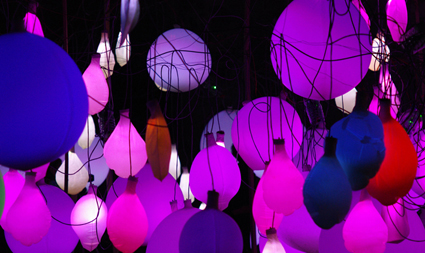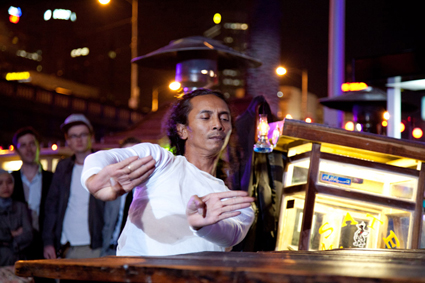July 24 2013
Past-present tensions
Keith Gallasch, Naala-Ba (Look Future), Carriageworks and ISEA2013
July 3 2013
Data noise & the limits of dance
Keith Gallasch, Myriam Gourfink & Kaspar Toeplitz, Breathing Monster
June 26 2013
Nailing the virtual
Virginia Baxter, Keith Gallasch, The Portals
Night work
Keith Gallasch, Embodied Media, Night Rage
Palpable virtualities
Keith Gallasch, Paula Dawson, Holoshop: Drawing and Perceiving in Depth
The big connect
Somaya Langley, The Portals
Transformational walking
Anne Phillips, Long Time, No See?
June 18 2013
Musical multiverses
Gail Priest, Polysonics
Rainbow over ISEA
Keith Gallasch, Electric Nights
realtime tv @ ISEA2013: Zydnei, Troy Innocent
June 17 2013
If a system fails in a forest, is anybody listening?
Urszula Dawkins, If a system fails in a forest…, 107 Projects
June 16 2013
In the digital age, love your stationery obsession
Urszula Dawkins, Durational Book
Painting by algorithms
Keith Gallasch, Ernest Edmonds: Light Logic
June 15 2013
Home, sweet home
Urszula Dawkins, disSentience, Sleeth, SelgasCano, Tin Sheds
Pop up pleasure zones
Gail Priest, Electronic Art Pop-Ups, The Rocks
June 14 2013
Aural ecologies, mechanical and musical
Urszula Dawkins, EchoSonics, UTS Gallery
June 14 2013
Heck, baby, I shoulda seen it comin…
Urszula Dawkins, The Very Near Future, Alex Davies
More than meets the eye
Virginia Baxter, Keith Gallasch, Point of View
New tools and old skool grammars
Gail Priest, Macrophonics II
realtime tv @ ISEA2013: The very near future, Alex Davies
Start by leaping off a small stool
Urszula Dawkins, ISEA Closing Keynote Address: Julian Assange
June 13 2013
A curative dose of spontaneity
Lauren Carroll Harris, pvi collective, Deviator
M e d i a a r t t h e n a n d n o w
Darren Tofts, Catching Light, Campbelltown Arts Centre
Olfaction, decay & speculation
Gail Priest, Raewyn Turner & Brian Harris, Ian Haig, Nandita Kumar, Verge Gallery
ART, WELLNESS & DEATH
Riding the theta waves
Urszula Dawkins, Theta Lab, George Poonkhin Khut and James Brown
Run for your lives [2]
Keith Gallasch, Running the City, COFA, UNSW
To re-map and reclaim
Lisa Gye, Mapping Culture [panel]
Turning the media back on itself
Lisa Gye, Mark Hosler, Adventures in Illegal Art
June 12 2013
Outside the labyrinth…looking in at someone waving
Urszula Dawkins, SoundLabyrinth, Mark Pedersen and Roger Alsop
realtime tv @ ISEA2013: semipermeable (+), SymbioticA
Run for your lives [1]
Keith Gallasch, Marnix de Nijs, Run Motherfucker Run
June 12 2013
The uncanny in the gallery
Keith Gallasch, Mari Velonaki, Simon Ingram, Petra Gemeinboeck & Rob Saunders, Artspace
June 11 2013
realtime tv @ ISEA2013: EchoSonics, UTS Gallery
The science and art of tangible things
Urszula Dawkins, Synapse: A Selection, Powerhouse
Touch me there
Gail Priest, ISEA Artist talks: Siu, Baumann, Velonaki
June 10 2013
Being Stelarc
Gail Priest, Stelarc: Meat, Metal, Code: Engineering affect and aliveness
Life and death, and the membranes inbetween
Urszula Dawkins, semipermeable (+), SymbioticA
realtime tv @ ISEA2013: Catching Light, Campbelltown Arts Centre
June 9 2013
'Pure' experience, in the round
Urszula Dawkins, Pure Land, iCinema
Data lives
Gail Priest, Genevieve Bell, Mark Hosler, Paolo Cirio & Alessandro Ludovico
realtime tv @ ISEA2013: Velonaki, Ingram, Gemeinboeck & Saunders, Artspace
June 8 2013
Knowing your place in Cartesian space
Gail Priest, Ryoji Ikeda, datamatics [ver 2.0]
Stars and starlings, pixels and picknickers
Urszula Dawkins, Ryoji Ikeda, datamatics [ver 2.0] & test pattern
 |
Celebra
courtesy the artists |
Nature attempts to outstrip ISEA2013 with a brilliant, painterly light show as delegates and guests are ferried up the mangrove-lined narrows of the Parramatta River. Save for a strip of blue on the horizon, where the sun burnishes low hanging clouds, the sky is amorphously grey. Suddenly there are cries and approving murmurs, cameras shuttering, iPhones flashing, passengers coursing onto deck to see a vast double rainbow arching high behind the ferry, intensely vibrant where it reaches earthwards.
As the rainbow fades and we once again face the windward chill, the sun impressionistically dusts soft waves of faint cloud with rich and oranges and reds against the grey. Will Electric Nights—an ISEA2013 riverside evening event in Parramatta—withstand the challenge? It does, on its own terms.
As we walk from the ferry in the early dark, tall shafts of blue and pink light dress buildings, creating a sense of a large, contained, festive space between two bridges. Beneath one of them is Josh Wodak’s Archangle Assemblages, in which five riders perch on bicycles, pedalling in synch to generate enough power to harmoniously trigger a pattern on the grid of bulbs that hangs before them. The work “generate[s] audiovisual rhythms and reference[s] the bioluminescence of fireflies as they synchronise their flashing” (program note). Harmony doesn’t always come easy, even for a cooperative species such as ours, so sweat is expended and competitiveness kept in check as the riders pedal to achieve unanimity at speed.
A mass of large white balloons hangs beneath the bridge on the opposite bank. Suspended at human height they are jostled by the breeze, wandering adults and romping children. They glow unanimously and serenely with a soft blues, then pinks and later greens, each balloon lit from within. Later, to throbbing dance music and the cries of happy dancers, waves of more intense colours surge through the cloud-like mass and individual balloons flare on their own. True to its title, Celebra (Christian Clark, Fabrizio Devoto, Paul Grindel & Tomas Laurenzo, Uruguay), with its 200 LED-lit balloons, is a sensory delight, generating an instant party.
On the pathway we encounter a trio of strange, figures – futuristic stilt walkers bathed in their own data-flow lighting and sound. Framed by stylish thin metal extensions of their arms and legs the performers are transformed into cyborgs. Not of the Exterminator variety, these serene Stalker Theatre creations (director David Clarkson, designer Alejandro Rolandi) simply are — there are no tricks, no personalities, no agenda that we can perceive. When will they turn on us? Or we on them — are they illegals? Or will we, in the due course of techno-evolution, become them? That is scary. Eric Siu’s very strange, helmeted Touchy adds a more amiable sense of the cyborg as he blindly offers his touch to passersby so they can enable him to record a moment of fleeting intimacy on film.
 |
Grobak Padi
photo James Henry |
In Grobak Padi (creative director Michael Hornblow), three traditional, pedal-driven Indonesian food carts and their cooks are not only the providers of, on this occasion, free nourishment but also, with monitors hanging from their frames, they are stations for the real time relay of performances between Jogjakarta and Sydney. A fourth, boat-shaped Grobak Padi arrives on a riverbank stage, accompanied by a synthesis of a pulsing hum and sweet high voices, smoke billowing from its small charcoal stove. A man in suit (Tony Yap), a potential customer, approaches the cart, leaves his coat and glasses on its roof and wanders away into a private dance.
The vendor (Agung Gunawan) arrives in traditional dress and a long, flowing white scarf, moving elegantly about his cart, stepping onto the bicycle and balancing on one foot on the seat where he ‘pedals’ as if flying. The man spins, jumps and bounces, his movements staccato and increasingly robotic, the palm of one hand directed to his face as if obsessed. When the cook places a white female mask over his face, the two commence a strange, lyrical duet — the transformed cook astride the man, the man restraining the cook, covering the eyes of the mask. Eventually harmony is achieved — the couple exiting slowly through an intrigued audience of ISEA delegates, guests, families and young people — hungry for meaning and soon satisfied by satays and the other pleasures generously on offer from a cleverly curated and staged Electric Nights.
Electric Nights, producer Carli Leimbach, ISEA2013 & Parramatta City Council
Parramatta River Foreshore, 14, 15 June; http://www.isea2013.org/
This article first appeared on RT's ISEA2013-in RealTime blog
© Keith Gallasch; for permission to reproduce apply to [email protected]
Back to top










 back
back